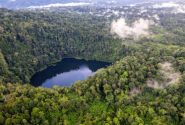
The Congo Basin contains the world’s second largest area of tropical forests – but a quarter is marked out for logging. Ollivier Girard/CIFOR
Scientists are working with national authorities and local populations in the Congo Basin to develop multiple-use forest management systems, which sees forest resources optimized for sustainable production of forest products and services such as timber, water regulation, food production, cultural needs and energy demands.
But Robert Nasi, Director of the CGIAR Research Program on Forests, Trees and Agroforestry, says few governments enforce this mechanism.
“The political culture is not about sharing resources, it is about each small section making it for itself,” he said.
“There is a fear that by joining forces with another ministry, separate government autarchies will lose their power.”
The issue is explored in a recent study by the Center for International Forestry Research and the Centre de coopération internationale en recherche agronomique pour le développement (CIRAD), examining whether biodiversity and timber production can co-exist in the Congo Basin’s forests.
Located in sub Saharan Africa, the Congo Basin contains the world’s second largest area of tropical forests and one of the richest biodiversity – including a number of the world’s threatened great ape species.
It’s also an ecosystem that supports the livelihoods of some 60 million people, who harvest timber and non-timber forest products such as bushmeat, fish, fruits and nuts for subsistence and commercial use.
However, around 26 percent of the Congo Basin sub-region has now been allocated for industrial logging concessions. To operate, forest laws from all countries in the region mention that the concessions require a technical document called a Forest Management Plan.
Typically, this plan includes a systematic inventory of all tree species above a certain diameter prior to deciding which volumes for which species would be harvested in the concession.
Management norms also require concession holders to detail socio economic aspects of the concession and its surrounding areas, geographic and geological characteristics, and occurring fauna and flora, all of which should impact the way concession holders operate.
The purpose is that this will not only encourage species conservation, but also improve the quality of life of local communities, through job creation and training.
“However the quality of such studies varies considerably,” said Alain Billand, scientist at CIRAD and co-author of the study.
Biodiversity is particularly poorly taken into account by “single-use” forest management plans that use timber as the sole economic resource. These plans generally ignore broader sustainability concerns, notably involving local populations.
Need for harmonised efforts to protect biodiversity
The authorities in charge of biodiversity concerns in forest concessions remains poorly coordinated in the region.
And, each administration – one in charge of concessions, and the other tasked with protected areas – considers only its own planning process and has very limited procedures to harmonise activities in the field.
“For instance, production forests and protected area administrations — sometimes belonging to the same ministries — consider only their own planning processes and have very limited procedures to harmonise activities in favour of biodiversity in the field,” Billand said.
However, as market pressures demand timber sources that are both environmentally and socially sustainable, some companies in the sub-region are starting to see the value of getting in line.
A recent study on the Tri-National Sangha landscape in Cameroon showed that a mix of logging concessions and protected areas has provided a good balance between conservation and local development. Wildlife such as the endangered bongo antelope, forest elephants, gorillas, and birds remain abundant in the logged areas. Forests also seemed to recover well after logging, the study showed.
“In spite of the region’s problems, it is possible to develop multiple-use forest management plans combining protection and production,” Nasi said.
“However this will require involvement of all stakeholders in the design and implementation of the management plans.”
For more information about the issues discussed in this article, please contact Robert Nasi at r.nasi@cgiar.org
This work forms part of the CGIAR Research Program on Forests, Trees and Agroforestry and was supported by USAID and the European Commission.
This issue will be one of the topics of discussion at the two-day conference Sustainable forest management in Central Africa: Yesterday, today and tomorrow Yaounde, Cameroon. 22-23 May, 2013.
For CIFOR’s special feature on Central Africa’s forests, visit forestsnews.cifor.org/yaounde
We want you to share Forests News content, which is licensed under Creative Commons Attribution-NonCommercial-ShareAlike 4.0 International (CC BY-NC-SA 4.0). This means you are free to redistribute our material for non-commercial purposes. All we ask is that you give Forests News appropriate credit and link to the original Forests News content, indicate if changes were made, and distribute your contributions under the same Creative Commons license. You must notify Forests News if you repost, reprint or reuse our materials by contacting forestsnews@cifor-icraf.org.












